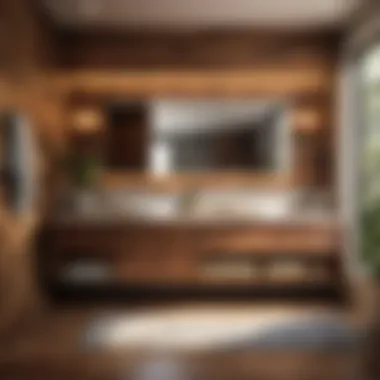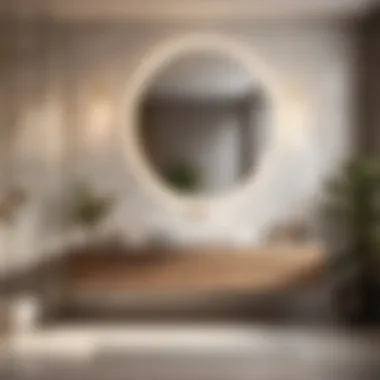Unlocking the Beauty and Functionality of the Standard Bathroom Vanity: A Comprehensive Guide


Materials:
- Vanity cabinet (measuring 36 inches in width, 21 inches in depth, and 32 inches in height)
- Sink basin (ceramic material, 16 inches in diameter)
- Faucet fixture (brushed nickel finish)
- Vanity countertop (quartz material, 1 inch thickness)
- Mounting hardware (screws, bolts)
DIY Steps:
- Prepare the Space: Measure and mark where the vanity will be installed, ensuring proper clearance for the cabinet doors and drawers.
- Assemble the Vanity: Follow the manufacturer's instructions to assemble the vanity cabinet, attaching the doors and drawer fronts securely.
- Install the Sink: Place the sink basin onto the pre-cut hole in the countertop, applying a bead of silicone sealant to prevent leaks.
- Mount the Faucet: Attach the faucet fixture to the pre-drilled holes in the countertop, securing it tightly to prevent wobbling.
- Attach the Countertop: Place the vanity countertop onto the cabinet base, ensuring a snug fit and using mounting hardware to secure it in place.
Technical Aspects:
- Tools required: measuring tape, screwdriver, adjustable wrench, silicone sealant
- Timing specifics: Allow 4-6 hours for complete installation, including assembly and mounting
- Critical techniques: Ensure all connections are watertight, level the vanity for proper drainage
DIY Project Process:
- Detailed Installation Method: Carefully follow the manufacturer's instructions for each component, double-checking measurements and alignment to avoid mistakes.
- Key Techniques and Timings: Keep the vanity level during installation to prevent water pooling around the sink, tighten all fixtures and connections securely.
- Troubleshooting Tips: If the sink leaks, check the sealant application; if the faucet drips, inspect the connections for any loose fittings and tighten as needed.
Introduction to Bathroom Vanities
The bathroom vanity serves as a focal point in the bathroom space, combining both practical functionality and aesthetic appeal. Understanding the key components and considerations when choosing a bathroom vanity is essential for anyone looking to elevate their bathroom design. As we delve into the realm of bathroom vanities, we will explore the intricate details of their design, materials, sizing, installation, and the latest trends to assist housewives and house owners in making informed decisions.
Understanding the Importance of Bathroom Vanities
Enhancing Storage and Organization
Enhancing storage and organization within the bathroom is a crucial aspect of the vanity. By providing ample space for storing bathroom essentials such as toiletries, towels, and cleaning supplies, the vanity contributes to keeping the bathroom space clutter-free and organized. The inclusion of different drawer types and configurations allows for efficient storage solutions, maximizing space utilization. The clever design of vanity cabinets ensures that every item has its dedicated place, promoting tidiness and ease of access for users.
Adding Aesthetic Value to the Bathroom
Apart from its practical utility, the bathroom vanity plays a pivotal role in enhancing the overall aesthetic of the bathroom. The choice of materials, finishes, and design styles can transform a mundane bathroom into a luxurious retreat. Incorporating visually appealing elements such as unique hardware finishes, intricate carving details, or sleek modern lines can elevate the bathroom's visual appeal, creating a cohesive and inviting ambiance. The vanity's aesthetic value not only enhances the bathroom's decor but also reflects the homeowner's style preferences, adding a personal touch to the space.
Evolution of Bathroom Vanity Designs
Traditional vs. Modern Styles
The dichotomy between traditional and modern vanity styles offers a plethora of design options for homeowners to choose from, each with its distinct characteristics. Traditional vanities often feature ornate details, intricate woodworking, and rich finishes, exuding a timeless and elegant charm. In contrast, modern vanities embrace minimalism, clean lines, and innovative materials to create a sleek and sophisticated look. Homeowners can select a style that complements their existing decor scheme and personal aesthetic, bridging the gap between classic elegance and contemporary chic.


Innovative Features and Technologies
Innovative features and technologies integrated into modern bathroom vanities enhance functionality and convenience for users. From motion-sensor lighting and defogging mirrors to built-in charging stations and Bluetooth connectivity, these technological advancements redefine the bathroom vanity experience. Smart storage solutions, such as pull-out organizers and adjustable shelves, optimize space utilization and cater to the evolving needs of homeowners. By incorporating these cutting-edge features, bathroom vanities are not only practical fixtures but also innovative companions in the daily routine, setting new standards for modern living.
Key Components of a Standard Bathroom Vanity
In the realm of bathroom design, the key components of a standard bathroom vanity play a pivotal role in both functionality and aesthetics. From defining the overall layout of the space to providing essential storage solutions, each component contributes to the harmony and efficiency of the bathroom. Understanding the significance of these key elements is crucial for homeowners seeking to optimize their bathroom experience.
Sink and Countertop
Materials and Finishes:
When it comes to the sink and countertop materials and finishes in a bathroom vanity, the choice is essential for both durability and visual appeal. Selecting the right materials can enhance the longevity of the vanity while adding a touch of sophistication to the space. Common materials like ceramic, porcelain, marble, or granite are popular due to their durability and aesthetic versatility. Moreover, finishes such as matte, glossy, or textured surfaces can impact the overall look and feel of the vanity, complementing the bathroom's design theme.
Single vs. Double Sink Options:
Deciding between a single or double sink configuration is a crucial consideration for bathroom vanities. Single sinks are ideal for smaller bathrooms or powder rooms, maximizing countertop space and providing a sleek, minimalist look. On the other hand, double sinks offer enhanced functionality for shared bathrooms, allowing multiple users to utilize the vanity simultaneously. Choosing the appropriate sink option depends on the space available, usage requirements, and design preferences of the homeowner.
Cabinets and Storage
Drawer Types and Configurations:
The drawer types and configurations within a bathroom vanity are integral to efficient organization and storage. Different drawer styles, such as standard drawers, pull-out shelves, or specialty compartments, cater to varying storage needs. Configurations like deep drawers for towels, shallow drawers for toiletries, and hidden compartments for cleaning supplies ensure a clutter-free and organized bathroom space. Selecting the right drawer types and configurations can optimize storage capacity and accessibility within the vanity.
Innovative Storage Solutions:
Innovative storage solutions revolutionize the functionality and convenience of bathroom vanities. Features like built-in dividers, adjustable shelving, or pull-out organizers maximize every inch of storage space while keeping essentials easily accessible. Utilizing innovative storage solutions not only enhances the efficiency of a bathroom vanity but also elevates the overall user experience by streamlining daily routines and maintaining a tidy environment.
Mirror and Lighting Fixtures
LED Lighting Options:
LED lighting options bring modern aesthetics and energy efficiency to bathroom vanities, creating a well-lit and inviting ambiance. LED lights offer customizable brightness levels, color temperature options, and longevity, making them a popular choice for illuminating vanity areas. Their low energy consumption and minimal heat output contribute to environmentally friendly and cost-effective lighting solutions for bathrooms. Utilizing LED lighting can enhance task lighting for grooming, accentuate the vanity design, and contribute to a visually appealing bathroom environment.
Mirror Shapes and Sizes:
The selection of mirror shapes and sizes is a crucial design aspect that influences the visual impact of a bathroom vanity. Mirrors not only serve functional purposes but also act as decorative elements that reflect light and create an illusion of space. Choosing the right mirror shape, whether rectangular, oval, round, or asymmetrical, can enhance the vanity's aesthetic appeal and complement the overall design scheme of the bathroom. Additionally, selecting appropriate mirror sizes in proportion to the vanity dimensions can further enhance the functionality and visual balance of the space.


Choosing the Right Size Vanity for Your Space
Choosing the right size vanity for your space is a crucial aspect of bathroom design, impacting both functionality and aesthetics. A well-fitted vanity can maximize storage efficiency while complementing the overall layout of your bathroom. In this section, we will delve into the key considerations and benefits of selecting the appropriate vanity size.
Measuring and Evaluating Space Requirements
When determining the ideal size for your vanity, several factors come into play to ensure a harmonious blend of form and function. One of the primary aspects to assess is the available space in your bathroom. By accurately measuring the area where the vanity will be placed, you can avoid overcrowding or leaving unused gaps within the room. This meticulous evaluation helps in creating a balanced and practical layout, optimizing the use of your bathroom space.
Factors to Consider
Factors such as the dimensions of the room, the placement of plumbing fixtures, and traffic flow must be taken into account. Understanding these elements allows you to customize the vanity size accordingly, ensuring seamless accessibility and a comfortable user experience. By considering these factors, you can tailor the vanity to suit your specific needs and enhance the functionality of your bathroom ecosystem.
Optimal Sizing Guidelines
Optimal sizing guidelines not only promote efficient use of space but also contribute to the aesthetic appeal of your bathroom. By adhering to these guidelines, you can achieve a well-balanced layout that prevents visual clutter and encourages a sense of openness. Incorporating these standards in your vanity selection process leads to a harmonious integration within your bathroom design, elevating the overall look and feel of the space.
Customization Options
In the realm of vanity dimensions, customization offers a personalized touch to address unique requirements and preferences. Tailoring the vanity's size to fit your needs involves adjusting height, width, and depth to optimize storage and functionality. This tailored approach allows you to design a vanity that aligns with your lifestyle and design sensibilities, fostering a sense of ownership and individuality within your bathroom space.
Tailoring the Vanity to Fit Your Needs
Customizing the vanity size ensures that it caters to your specific storage needs and aesthetic preferences. Whether you require extra drawers for organization or a compact design for a smaller bathroom, tailoring the vanity allows you to create a personalized solution that enhances your daily routine. This flexibility in sizing empowers you to design a vanity that reflects your lifestyle and meets your practical requirements.
Space-saving Solutions
For smaller bathrooms or limited space configurations, space-saving solutions offer innovative ways to maximize functionality without compromising on style. These solutions often include compact designs, built-in storage options, and creative layouts that optimize the use of available space. By leveraging these space-saving techniques, you can design a vanity that is both efficient and visually appealing, transforming your bathroom into a well-organized and inviting sanctuary.
Materials and Finishes for Bathroom Vanities
The section on Materials and Finishes for Bathroom Vanities in this article plays a crucial role in understanding the intricacies of bathroom vanity design. When selecting materials and finishes, there are specific elements to consider to ensure both functionality and aesthetic appeal of the vanity. The choice of materials like wood and finishes such as water-resistant options significantly impacts the durability and style of the vanity.
Wood Varieties and Their Characteristics
Solid Wood vs. Engineered Wood


Solid wood and engineered wood are two common options when it comes to bathroom vanity construction. Solid wood offers a classic and natural look with its unique grain patterns and colors. It is well-known for its sturdiness and longevity, adding a touch of elegance to any bathroom. On the other hand, engineered wood is a more cost-effective alternative that provides similar aesthetics to solid wood but with increased resistance to moisture and humidity. This makes engineered wood a practical choice for bathroom vanities where water exposure is common.
Water-Resistant Options
Water-resistant finishes are essential for bathroom vanities due to the high levels of moisture present in bathrooms. These finishes protect the vanity from water damage, warping, and mold growth. Opting for water-resistant materials ensures longevity and easy maintenance of the vanity, making it a popular choice for modern bathrooms. Additionally, water-resistant options offer versatility in design, allowing homeowners to achieve various styles without compromising on durability.
Choosing the Right Finish
Selecting the right finish is vital in enhancing the appearance and performance of a bathroom vanity. Factors influencing finish selection include durability, aesthetics, and maintenance requirements. By understanding these factors, homeowners can choose a finish that aligns with their preferences and budget, ensuring long-term satisfaction with their vanity choice.
Factors Influencing Finish Selection
Factors such as the level of gloss, texture, and ease of cleaning influence the selection of finishes for bathroom vanities. High-gloss finishes provide a sleek and modern appearance, while matte finishes offer a more understated and classic look. Additionally, textured finishes can add depth and dimension to the vanity, creating visual interest in the bathroom space. Considering these factors allows homeowners to personalize their vanity while meeting practical needs.
Popular Finish Options
Popular finish options for bathroom vanities include matte, gloss, and painted finishes. Matte finishes are favored for their ability to hide fingerprints and water spots, making them ideal for busy households. Gloss finishes, on the other hand, reflect light and lend a luxurious feel to the vanity. Painted finishes offer a customizable choice, allowing homeowners to match the vanity with their overall bathroom decor. Understanding the unique features and advantages of each finish option helps homeowners make informed decisions that suit their style preferences and functional requirements.
Installation and Maintenance Tips
In the realm of standard bathroom vanities, understanding the nuances of installation and maintenance is pivotal to ensure a seamless and long-lasting experience. The installation process sets the foundation for the vanity's functionality and aesthetic appeal, making it a crucial step in the overall bathroom improvement journey. Similarly, adhering to proper maintenance practices is essential to preserve the vanity's quality and extend its lifespan.
Professional vs. DIY Installation
Considerations and Challenges
Embracing the choice between professional and DIY installation carries significant implications for both the outcome of the vanity setup and the homeowner's overall satisfaction. Delving into the considerations and challenges of this decision reveals the complexities involved in achieving a flawless installation. Factors such as skill level, time commitment, and budget constraints play a pivotal role in determining the most suitable approach. Professional installation guarantees expertise and precision, ensuring a seamless integration of the vanity into the bathroom space. On the contrary, opting for a DIY approach presents challenges related to skill requirements, potential errors, and time constraints. The nuanced balance between these considerations shapes the foundation of a successful and stress-free installation process.
Ensuring Proper Alignment
The art of ensuring proper alignment during the installation phase is a critical aspect that significantly impacts the functionality and visual appeal of the bathroom vanity. Proper alignment involves meticulous attention to detail, precision in measurements, and adherence to design specifications. By prioritizing alignment, homeowners can avoid common pitfalls such as uneven surfaces, misaligned fixtures, and aesthetic discrepancies. This attention to detail not only enhances the vanity's overall look and feel but also contributes to its structural integrity and longevity. Maintaining proper alignment requires a keen eye for precision and a commitment to accuracy throughout the installation process. By focusing on this crucial element, homeowners can elevate the functionality and aesthetic value of their bathroom space.
Cleaning and Care Guidelines
Effective cleaning and care guidelines are essential to preserve the pristine condition of a standard bathroom vanity and ensure its longevity. By implementing proper dos and don'ts as well as protective measures, homeowners can safeguard their investment and maintain the vanity's appearance for years to come.
Dos and Don'ts
Understanding the dos and don'ts of vanity cleaning is crucial in maintaining its beauty and functionality. Proper dos include using mild cleaners, soft cloths, and regular dusting to prevent dirt buildup and maintain a sparkling surface. On the other hand, avoiding harsh chemicals, abrasive materials, and prolonged exposure to moisture are key don'ts to protect the vanity's finish and materials. By adhering to these guidelines, homeowners can preserve the integrity of their bathroom vanity and enjoy its aesthetic appeal for the long haul.
Protective Measures
Implementing protective measures is paramount in safeguarding the vanity against common wear and tear factors. Installing soft-close mechanisms, using felt pads under accessories, and avoiding placing heavy items directly on the vanity surface are effective measures to prevent scratches, dents, and other damages. Additionally, applying sealants or protective coatings can enhance the vanity's resistance to moisture and prolong its lifespan. By incorporating these protective measures into their cleaning routine, homeowners can ensure that their bathroom vanity remains a focal point of elegance and functionality in their living space.







